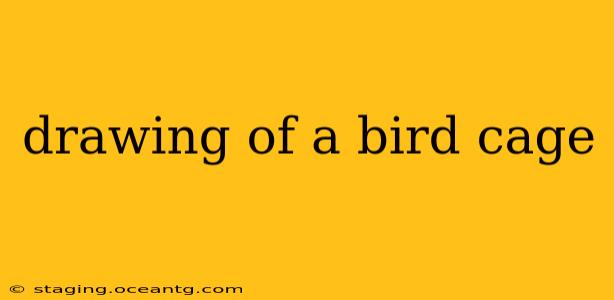How to Draw a Bird Cage: A Step-by-Step Guide for Beginners and Beyond
Drawing a birdcage might seem daunting, but with a little guidance, it's surprisingly simple and rewarding. This guide will take you through several approaches, from a basic outline to more detailed and complex designs, catering to various skill levels. We'll explore different styles and techniques to help you create your perfect birdcage drawing.
What You'll Need:
- Paper: Choose your preferred paper type – sketch paper, drawing paper, or even printer paper will work.
- Pencils: A range of pencils (H2, HB, 2B) will give you control over line weight and shading.
- Eraser: A good quality eraser is essential for corrections.
- Ruler (Optional): For more precise lines and measurements, especially for geometric cages.
- Sharpener: To keep your pencils sharp.
1. Basic Birdcage Drawing: A Simple Outline
This method is perfect for beginners. We'll start with a simplified representation focusing on the cage's overall shape and structure.
- The Base: Begin by sketching a slightly elongated rectangle or square for the base of the cage.
- The Sides: Draw four vertical lines extending upwards from each corner of the base. These will form the sides of the cage.
- The Top: Connect the top ends of the vertical lines to create the top of the cage. This can be a simple straight line or a slightly curved one, depending on your preference.
- The Door: Add a small rectangle or square on one of the sides to represent the cage door.
- The Bars: Lightly sketch vertical and horizontal lines across the sides to represent the cage bars. Don't worry about making them perfectly spaced at this stage.
2. Adding Detail and Realism
Once you have the basic outline, let's add more detail to make your birdcage drawing more realistic.
- Refine the Bars: Erase any overlapping lines and adjust the spacing of the bars to create a more even and visually appealing pattern. You can vary the spacing slightly for a more natural look.
- Add Texture: Use shading techniques to give the bars depth and dimension. Consider adding shadows to suggest light source and form.
- The Perches: Draw small branches or dowels inside the cage for perches.
- The Stand: Draw a simple stand or base to support the cage.
3. Exploring Different Birdcage Styles
There are many different types of birdcages. Experiment with different shapes and styles:
- Victorian Birdcage: This style often features ornate detailing, curved lines, and possibly a decorative top.
- Modern Birdcage: These tend to have clean lines, simple shapes, and a minimalist aesthetic.
- Antique Birdcage: This style often involves intricate metalwork and decorative elements.
How to Draw a Bird in a Birdcage?
Adding a bird enhances your drawing significantly. Start with a simple shape representing the bird's body and then add the head, wings, and tail. Remember to consider the bird's posture and position within the cage.
What are some easy birdcage drawing ideas?
Simple shapes are key to easy birdcage drawing. You could start with a rectangular cage, then add bars, a perch, a small door, and a simple stand. For a more complex design, consider drawing a circular cage or one with intricate details.
What are some tips for drawing a birdcage?
Practice is key! Start with simple sketches to develop your skill. Observe real birdcages – notice the shapes, proportions, and details. Use light pencil strokes initially, allowing for easy corrections.
By following these steps and experimenting with different techniques, you can create a stunning birdcage drawing, regardless of your skill level. Remember to have fun and let your creativity flow!
